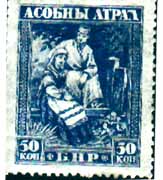DISPUTED TERRITORIES
After World War One ended and the provisions of the Treaty of Versailles
came into force, Poland was granted territories formerly held by Russia,
Germany and Austria. Additionally, Austria and Russia were fragmented
into other new countries which bordered Poland. Some areas on or
near the borders contained large numbers of Polish persons but were claimed
by Poland's neighbors. In order to protect the Polish population
in these areas, Poland made some territorial claims on it's borders
between 1918 and 1922. Until the disputes could be resolved (by plebiscite
or military action), postage was issued locally in these areas. They
included:
* Central
Lithuania - Litwa Srodkowa * Upper
Silesia - Gorny Slask * East
Silesia Cieszyn
* Western
Ukraine Zachodi Ukraina
* Marienwerder
Kwidzyn *
Allenstein
Olsztyn * Ukraine
* BialyRosja
Central Lithuania - Litwa Srodkowa
Return to top
Occupied in 1919 by Poland (thereby overthrowing
the LitBel Republic - a Bolshevik puppet government) and claimed because
the majority of the local population was Polish. The territory was
lost in early 1920, but retaken by Polish forces under General Zeligowski,
who entered Wilno (Vilnius) in October 1920. A plebiscite was held
in 1922, and the territory became part of Poland. This territory
was seized by the Soviet Union during the Second World War and now forms
part of Lithuania. Stamps were issued between 1920 and 1922.
Click
here to go to the Litwa Srodkowa page.
Upper Silesia- Gorny Slask
Return to top
Under dispute by Poland and Germany. Under
the provisions of the Treaty of Versailles (sections 88 and 90), a temporary
Allied Occupation Government Commission administered the area until a plebiscite
was held in 1921. Much controversy surrounds the fairness of the
vote, which divided the area between Poland and Germany. Stamps were
issued by the Allied Occupation Commission until the territory was divided.
Some un-official stamps were issued by the Polish and German Insurgents
during the Silesian Uprisings, in 1921.
Click here
to go to the Gorny Slask page.
Eastern Silesia
Return to top
An area disputed by Poland and Czechoslovakia.
This territory was divided up between Poland and Czechoslovakia, with the
border running through Cieszyn (Teschen). Both Polish and Czech stamps
were used with overprints during the dispute. Some of the territory
was retaken by Poland in 1938. Click
here to go to the Eastern Silesia page.
East Galicia - Western Ukraine
Return to top
Formerly part of the Austro-Hungarian Empire and
claimed by both Poland and the Western Ukrainian People's Republic.
Poland had gained some control of this area early in the 1918-21 war, but
fighting continued and the Western Ukrainians issued stamps (overprinted
Austrian Empire stamps) from Lwow (rare), Kolomyya and Stanislawow, until
Poland gained total control of the region in July, 1919. The area
was seized by the Soviet Union during WW II and incorporated into the USSR
as the result of the post-war re-drawing of the borders. Much of
this area is now part of Ukraine. Click
here to go to the Western Ukraine page.
Marienwerder
Return to top
A disputed area between Germany (West Prussia) and
Poland. Under the provisions of the Treaty of Versailles (sections
96 and 97), a plebiscite was held in 1920. The result of the vote
was in favour of Germany and this territory became German in late 1920.
Stamps were issued by the Inter-Allied Commission. German stamps
with "Commission Interalliee Marienwerder" overprints were also issued.
Known today as the area around Kwidzyn.
Click
here to go to the Marienwerder page
Allenstein
Return to top
A disputed area on the Polish/East Prussian border.
A plebiscite was held under the provisions of the Treaty of Versailles
(sections 94 and 95) in 1920, and this area became part of East Prussia.
German stamps with overprints were used until the vote. This area
is now part of Poland, and is known as Olsztyn.
Click here
to go to the Allenstein page
Ukraine
Return to top
During the 1918-21 war against the Bolsheviks, the
Polish army (allied with Ukrainians like Petlura) entered Kiev in May 1920
in the vain hope of setting up an independent Ukrainian Republic allied
with Poland. Petlura lost control of this area soon afterwards.
After the end of the 1918-21 war, the Ukraine was divided between Poland
and Russia. The majority of the Ukraine was held by Russia with disastrous
results. Stalin eventually caused the starvation of millions of Ukrainians.
Annexed by Russia as the Ukrainian Soviet Socialist People's Republic,
after which Soviet Russian stamps were used.
Click here
to go to the Ukraine page
BialyRussia
Return to top
As with the Ukraine, BialyRussia (Belorus) was also
the scene of fighting between Poland and Russia. During the Russian
civil war that followed the Bolshevik revolution, General Bulak-Balachowicz
led an anti-Bolshevik force in BialyRussia. Many Poles fought under
his command against the Bolsheviks. After the end of the Polish-Russian
war of 1918-21, BialyRussia was divided between Poland and Russia, with
Russia retaining the larger portion.

It was reputed that a set of 5 stamps was issued in 1920 to be used
by General Bulak-Balachowicz's forces, but it can not be confirmed
if they were actually used.
Return to
Stamp page